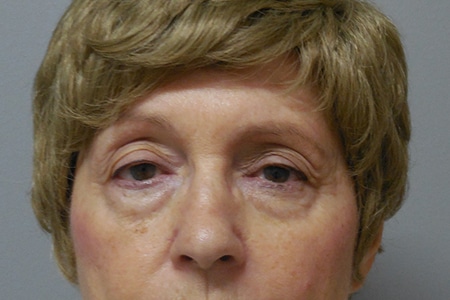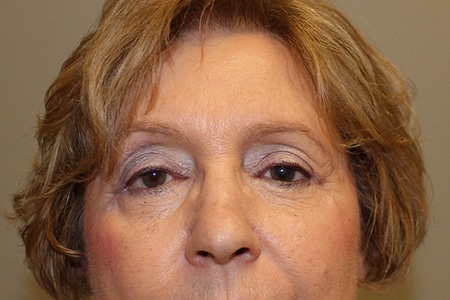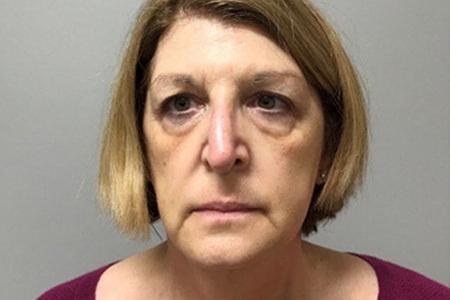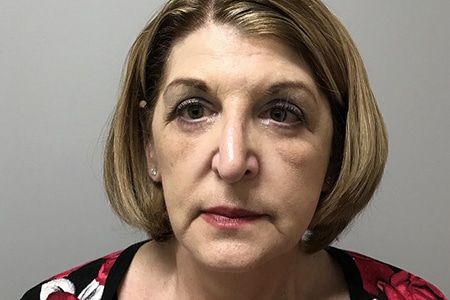Quick Links
- What Is Eyelid Surgery?
- Eyelid Surgery Benefits
- Reasons For Eyelid Surgery
- Before And After Photos
- Good Candidates For Eyelid Surgery
- Preparing For Eyelid Surgery
- Eyelid Surgery Procedure
- Eyelid Surgery Recovery
- Results Of Eyelid Surgery
- Risks Of Eyelid Surgery
- Combination Procedures
- Cost Of Eyelid Surgery
- What To Expect From An Eyelid Surgery Consultation
- Frequently Asked Questions
- Schedule A Consultation
DiFrancesco Plastic Surgery performs upper and lower blepharoplasty procedures for patients who wish to give their eyelids a more youthful appearance.
Dr. DiFrancesco will perform a comprehensive exam and discuss your treatment options during your consultation. Blepharoplasty can be performed under local anesthesia with light sedation or general anesthesia as outpatient surgery.
What is Eyelid Surgery?
Blepharoplasty, or eyelid surgery, is performed on the upper and or lower eyelids to refresh and rejuvenate the eyes. Eyelid surgery improves the appearance of the eyelid by removing or repositioning excess fat, excess eyelid skin, or muscle. This will refine and rejuvenate your upper and lower eyelids. Dr. DiFrancesco is a board-certified plastic surgeon and fellowship trained in oculoplastic surgery. She has published several papers on eyelid surgery including her latest chapter on fat grafting and complication of the periorbital region. Dr. DiFrancesco specializes in both primary blepharoplasty and secondary or revisional blepharoplasty procedures.
DOWNLOADABLE GUIDE
Get the information on this page for FREE in a PDF format
Eyelid Surgery Benefits
Eyelid surgery, or blepharoplasty, offers numerous benefits, including rejuvenating the appearance of tired or droopy eyes. The procedure removes excess skin and fat, creating a smoother area around the eyes. Improved vision may also result when sagging eyelids are corrected.
Reasons for Eyelid Surgery
Eyelid surgery is performed to address drooping upper eyelids, under-eye bags, or excess skin that impairs vision. Some patients seek the procedure to achieve a more rested and youthful appearance. Both functional and cosmetic reasons make blepharoplasty a popular choice.
Before and After Photos
Before and after photos showcase our patient results, offering visual evidence of the procedure’s potential. Reviewing these photos can help you set realistic expectations during the consultation.
Good Candidates for Eyelid Surgery
Ideal candidates for eyelid surgery are healthy individuals with no serious eye conditions who want to enhance their appearance. Common concerns include droopy upper eyelids, puffiness, or fine wrinkles around the eyes. A consultation helps determine if the procedure aligns with your goals.
Preparing for Eyelid Surgery
Preparation for eyelid surgery includes a thorough medical evaluation and adjustments to medications as directed by your surgeon. Avoid smoking and supplements or medications that may increase bleeding risk. Following preoperative instructions ensures optimal results and a smooth recovery.
Eyelid Surgery Procedure
The upper eyelid incision is placed in the natural upper eyelid crease to avoid a visible scar. Dr. DiFrancesco will determine how much excess skin and fat to remove to give you a youthful and natural look. Patients with pre-existing dry eyes will have less skin resection to prevent the dry eye from becoming worse. A browlift procedure such as a direct browlift, medial browlift, temporal browlift, coronal browlift, or endoscopic browlift may be performed at the same time as your blepharoplasty. A ptosis procedure would be completed at this point to repair the levator aponeurosis. Finally, sutures are used to close the skin followed by antibiotic ointment dressing. Post-operative care includes keeping your head elevated, resting, and using ice packs and lubricant drops.
There are several options available for your lower eyelid blepharoplasty depending on your underlying bone structure, tissue descent, muscle thickness, and soft tissue atrophy.
A transconjunctival blepharoplasty makes an incision on the inside of the eyelid to avoid a visible scar. Transconjunctival eyelid surgery is most commonly used in patients with puffy eyes to remove fat in the power eyelid with no skin excess and no mild mid-face aging.
A transcutaneous blepharoplasty uses an incision just under the eyelashes and along the smile lines. A transcutaneous approach to lower eyelid surgery can be used to perform a cheek lift, place a fat graft in the tear trough or remove extra skin. Dr. DiFrancesco will use this approach for lateral canthal anchoring such as a canthopexy or canthoplasty to correct lower eyelid laxity seen with advanced aging.
Transcutaneous eyelid surgery is also used when secondary or revisional blepharoplasty is needed to correct asymmetry or a complication from trauma or previous eyelid surgery.
Ptosis
Ptosis is when your upper eyelid droops and begins to cover part or all of your pupil (dark part of the eye), thus limiting your vision. Ptosis can be congenital in children, neurogenic from nerve damage, myogenic from muscle damage such as myasthenia gravis, or mechanical. Mechanical ptosis occurs with age, after an eye injury, or as a side effect of surgery such as LASIK or cataract surgery.
Ptosis, when associated with aging, most commonly occurs from the levator muscle stretching and/or separating from the eyelid margin. Patients will often recruit the frontalis muscle in their forehead to help keep the upper eyelids open. This can cause unwanted horizontal wrinkles in your forehead from prolonged contraction of your frontalis muscle. Use of Botox to correct the horizontal forehead wrinkles may make your droopy eyelid worse. Most people experience worsening symptoms after remaining awake for long periods, allowing their muscles to get tired and their upper eyelids to droop.
Ptosis surgery often includes a blepharoplasty, depending on the degree of ptosis, which can be determined by a visual field test. Eyelid surgery for ptosis may be performed with IV sedation or general anesthesia. The ptosis repair can be done in conjunction with blepharoplasty by removing the extra skin and fat present in the upper eyelid. There is minimal pain and downtime after surgery with some bruising and swelling of the eyelids. Each person heals differently so allow 4 to 6 weeks for full recovery. Most patients experience improvement in their vision immediately upon resolution of the swelling.
Ectropion
Lower eyelid malposition occurs when the eyelid is pulled down away from the eye or the eyelid is turned outward, exposing the inner surface of the eyelid and making it prone to irritation. The most common causes of lower eyelid malposition include scarring from trauma, previous surgery, or a lower eyelid tumor.
Symptoms of eyelid malposition include watery eyes, dry eyes, irritation, and sensitivity to light.
The first step in determining treatment for your eyelid malposition is to diagnose the problem. Treatment depends on the cause of your eyelid malposition. Typically, treatment involves revisional blepharoplasty or lower eyelid surgery with canthal anchoring for lower eyelid support. This may include a cheek lift to recruit additional tissue in cases of severe scarring.
This procedure can be performed as an outpatient procedure under local anesthesia, with IV sedation, or with general anesthesia. Revisional blepharoplasty will take longer to heal than primary blepharoplasty with prolonged swelling. In total, expect 4 to 6 weeks of downtime and 6 months before you see your final results.
Wrinkles
While eyelid surgery primarily addresses sagging skin and fat, it can also reduce fine wrinkles around the eyes. The procedure smooths the delicate eye area, complementing other anti-aging treatments.
Eyelid Surgery Recovery
Recovery from eyelid surgery typically involves mild swelling and bruising, which subside within two weeks. Most patients return to normal activities after about ten days. Following your surgeon’s post-operative care instructions ensures a faster, more comfortable healing process.
Results of Eyelid Surgery
The results of eyelid surgery are long-lasting, with most patients enjoying a refreshed and youthful appearance for years. Functional improvements, such as better vision, can also enhance quality of life. Final results become apparent as swelling subsides over the first few months.
Risks of Eyelid Surgery
Although eyelid surgery is generally safe, risks include infection, scarring, and changes in sensation. Choosing an experienced surgeon such as Dr. DiFrancesco reduces these risks and ensures proper care. Discussing potential complications during your consultation prepares you for the procedure.
Combination Procedures
Eyelid surgery can be paired with other treatments for a more comprehensive rejuvenation.
Facelift
A facelift combined with eyelid surgery addresses sagging skin and wrinkles across the face and neck. This combination creates a more balanced and youthful appearance.
Neck Lift
Pairing a neck lift with eyelid surgery enhances the entire face and neck area, delivering a balanced and youthful appearance. This option is ideal for those with sagging neck skin and droopy eyes.
Cost of Eyelid Surgery
The cost of eyelid surgery varies based on factors such as your condition and the procedure’s complexity. A detailed cost estimate, including anesthesia and facility fees, is provided during your consultation. Flexible financing options may also be available to make the procedure more accessible.
What to Expect From an Eyelid Surgery Consultation
During an eyelid surgery consultation, Dr. DiFrancesco evaluates your medical history and discusses your aesthetic goals. You will receive a personalized treatment plan and have the opportunity to review before and after photos. This is also the time to ask questions and address any concerns about the procedure.
Frequently Asked Questions
Can Botox lift droopy eyelids?
Can droopy eyelids cause blurred vision?
Can I sleep on my side after eyelid surgery?
Can you get rid of hooded eyelids?
Does eyelid surgery leave scars?
How do you reduce bruising after eyelid surgery?
How long does eyelid surgery take?
How long does upper eyelid surgery take?
What causes droopy upper eyelids?
What are typical symptoms?
What causes your eyes to droop?
What are the symptoms of ptosis?
How long can this procedure take?
Schedule a Consultation
To rejuvenate your appearance, contact Dr. DiFrancesco today for a consultation. Make an appointment by calling our Atlanta office or filling out our online form.








